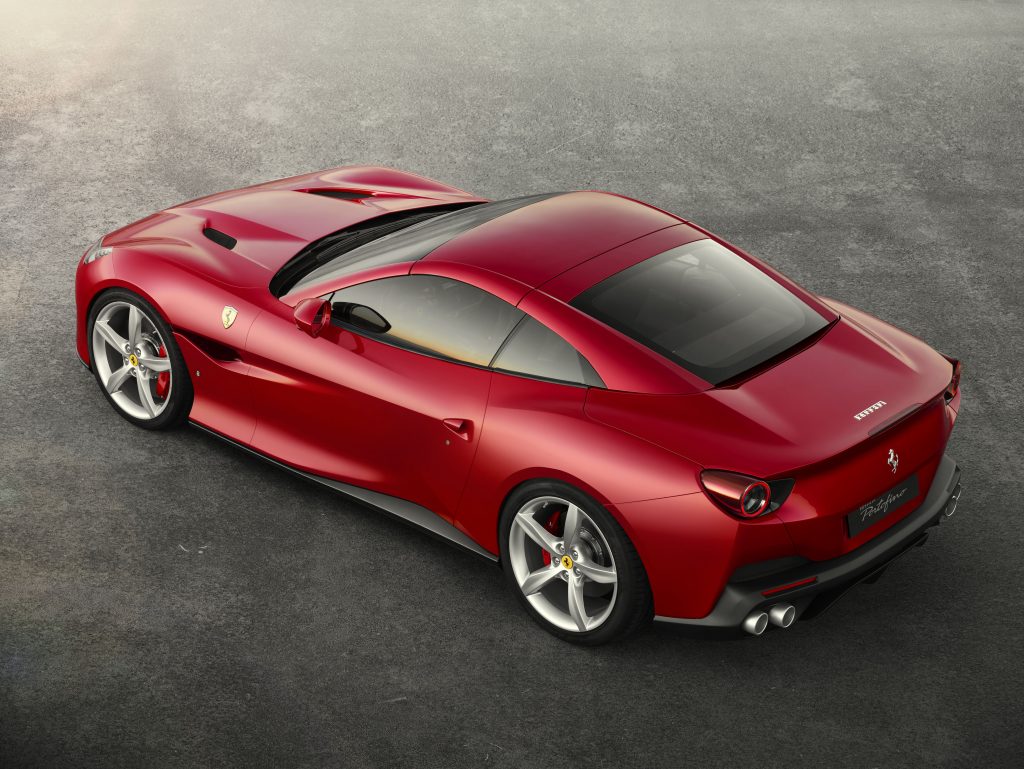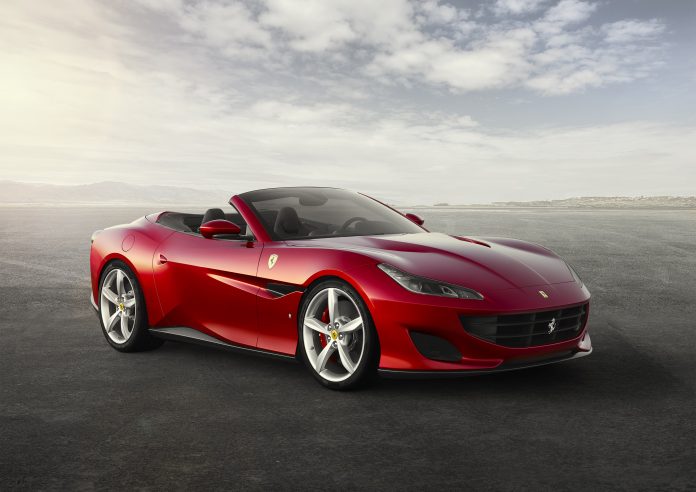Euro Motors, Bahrain’s official Ferrari importer-dealer, staged a preview of the latest GT – Ferrari Portofino. The chic event, held at the new Ferrari showroom in Bahrain, welcomed VIP clientele to take a closer look at the latest edition of the Italian stable.
Ferrari has chosen a particularly evocative name for this exceptionally versatile drop-top car. Portofino is renowned for its charming tourist port and, over the years, has become internationally synonymous with elegance, sportiness and understated luxury. The launch colour of the new Ferrari has also been dedicated to this marvellous town: Rosso Portofino.
Capable of unleashing a massive 600 cv and sprinting from 0 to 100 km/h in just 3.5 seconds, the Ferrari Portofino is the most powerful convertible to combine the advantages of a retractable hard top, a roomy boot and generous cockpit space plus two rear seats suitable for short trips.
The Ferrari Portofino’s all-new chassis features a significant weight saving over the California T it replaces. Thanks to the extensive use of modern production technologies, all the chassis and body-in-white components have been redesigned with a consequent reduction in weight despite an increase in torsional rigidity.
The Portofino is a Ferrari designed to be driven every day that also effortlessly converts from an authentic ‘berlinetta’ coupé to a drop-top capable of delivering a unique Ferrari soundtrack and superb driving pleasure even in day-to-day situations.
The retractable hard top (RHT) has been completely redesigned and can now be opened or closed in just 14 seconds on the move at lower speeds, making the car even more practical. Careful modelling of the RHT housing now allows the luggage compartment to hold two cabin trolleys with the roof down and three with the roof up. Ideal for any occasion, the Ferrari Portofino represents the perfect combination of design, performance and technology.
The Ferrari Portofino delivers a significant weight saving with the adoption of new components using innovative designs made possible by the use of cutting-edge production techniques. This, combined with a 40 cv higher power output than the California T, has resulted in a significant hike in performance and a corresponding drop in emissions. Vehicle dynamics benefit from the introduction, for the first time on this model, of electric power steering, the 3rd generation electronic differential (E-Diff3) and the latest evolution of the electronic suspension control system (SCM-E) integrated with Premium 9.1 ESP.
STYLE AND AERODYNAMICS
The Ferrari Design Centre-penned Portofino is an aggressively-styled car with a two-box fastback configuration – unprecedented in a coupé-convertible with a retractable hard top – that adds extra sleekness to its silhouette, lending it a sportier character without impinging on its elegance and dynamism.
As is always the case in Ferrari, the aerodynamic development process involved every single area of the car and its development, from the initial layout choices to the management of the flows involved in heat dissipation, and the definition of every single detail of the underbody and bodywork. The Aerodynamics department and Ferrari Design collaborated on a day-to-day based on the latter in particular.
The development process focused principally on aerodynamic efficiency with a particular emphasis on cutting drag which is pivotal to both pure performance, and on keeping fuel consumption and emissions down. This goal proved challenging as Ferrari’s engineers had to guarantee improved engine heat dissipation (as power output was boosted by 40 cv) which could have resulted in an increase in Cd over the previous model. Nonetheless, they managed not just to dissipate the increased heat energy without increasing radiator dimensions but also to achieve a drag (Cd) figure of 0.312 – an improvement of 6% over the previous model.
A subtle interplay and juxtaposition of concave and convex surfaces lends a sense of three-dimensionality to the body, yet also creates an impression of great naturalness which can be seen in the way the flows needed to increase aerodynamic efficiency were optimised.
At the edges of the large central radiator grille are two side air intakes for the intercoolers, while the two vents in the bonnet are larger and further apart to evacuate heat from the engine compartment without impacting occupant comfort with the top down.
The front of the car is also underscored by a new headlight assembly with a more horizontal development which is designed to follow the crest line of the front wheel arches. Half-hidden at the outer edges of the headlights are highly innovative aerodynamic “air curtain”-type intakes which vent into the front of the wheel housing to increase the evacuation of air coming from the wheel spokes and wheel arch and channel it along the scooped sides, thereby reducing drag created by the wake from the front wheels.
Great attention was also focused on the way in which the surfaces of the car’s flanks catch the light, creating a marked ‘chiaroscuro’ effect and thus breaking up the mass. Meticulous modelling of the curved profiles and tauter lines underscore the car’s design. A crease line runs from the edge of the bonnet along the front wheel arch and across the door. The result is a slender but well-defined belt-line which underscores the elongated muscle of the upper front wheel arch and the new air extraction fin, cleverly located to relieve the pressure inside the wheel housing via a clearly visible vent.
The trimaran design of the tail underscores the impression of solidity and breadth given by the rear stance. This elegant solution enabled the designers to skilfully sculpt the volumes in order to cleverly conceal the rear volume housing the RHT. The tail lights, which are now further apart rather than part of the boot lid, incorporate all of the optics to save weight.
Here, too, great attention was focused on the delicate parameters that influence the detachment of the air flow from the upper bodywork. The profile where the rear screen meets the rear spoiler has been optimised both in terms of volume and detail. The position of the tail lights meant that the spoiler, and thus the controlled flow detachment region, could be extended, cutting overall drag.
INTERIOR
While the Portofino’s exterior exudes a stylish compactness and instantly marks out its GT vocation, its cabin too has also been carefully designed and developed. The Ferrari Design team pinpointed certain specific essential requirements, the foremost of these being formal and functional coherency between the car’s exterior and its interior, weight reduction and creating more space for occupants.
Seen in plan view, the cockpit’s symmetrical arrangement and the improved rear seat space are clear. The dashboard architecture in particular features two shells, which incorporate all of the technical components, and a bridge which visually connects the instrument panel area with the central tunnel which, itself, was clearly conceived to act as a divider between driver and passenger.
One signature characteristic of any Ferrari car is the meticulous care lavished on the selection of the materials, trims and assembly procedures. The Ferrari Portofino’s sporty yet elegant character highlights these aspects of the creative and design processes demanded to hone every last detail, marrying high-tech elements and materials with manual assembly and handcrafted finishes.
The seats are also the product of a special research study and have an innovative magnesium structure. Different density padding and an ultra-compact seatback profile mean that there was more space to devote to the rear seats than in the previous model.
The optional 18-way adjustable electric seats ensure that even longer journeys are exceptionally comfortable and relaxing. Aside from longitudinal seat and backrest adjustment, the seat height and angle can also be adjusted, as can the side cushions and the central and lumbar regions of the backrest. The new Comfort button on the side of the front seats brings up on the infotainment display the controls for the adjustable-length seat cushion (which provides under-thigh support for even taller drivers), seat and backrest side and back support air cushions and heated seat.
In line with Ferrari’s other GTs, the Portofino’s HMI (Human-Machine-Interface) includes an instrument panel and dual TFT displays arranged around the rev counter in a generous circular anti-glare binnacle on exactly the same axis as the multifunctional steering wheel.
The passenger has a dedicated capacitive display. Directly linked to the main screen, it provides all information relating to car speed, rpm and gear engaged. Lastly, the infotainment system functionalities are controlled via the 10.25” touchscreen located at the centre of the dash within easy reach of both driver and passenger.
One of the contributors to improving in-car comfort is the impressive progress made in the efficiency of the air conditioning system with a 20% increase in air capacity and a contemporaneous reduction of 8dB in noise levels. Lastly, when the top is down, the new wind deflector cuts air flow over the body by 30%: -17% over the head and -40% over the chest. This results in an appreciable reduction in aerodynamic noise in the cabin.

Technical Specifications
Engine
Type V8 – 90°
Overall displacement 3855 cm3
Maximum power output * 441 kW (600 cv) at 7500 rpm
Maximum torque * 760 Nm from 3000 to 5250 rpm
Length 4586 mm
Width 1938 mm
Height 1318 mm
Weight distribution 46-54% front/rear
Performance
Maximum speed >320 km/h
0-100 km/h 3.5 sec
Fuel consumption and CO2 emissions**
Fuel consumption 10.5 l/100 km
Emissions 245g CO2/km
* In 7th gear
** Combined cycle. Under homologation. ECE+EUDC with standard HELE system.

